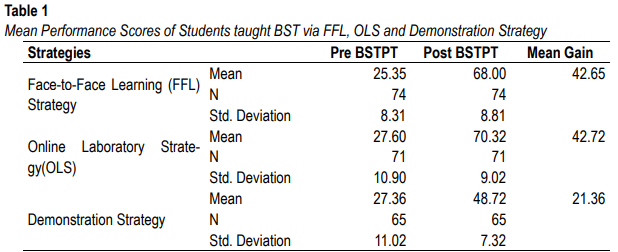Intervention in Students’ Performance in Basic Science and Technology Using Blended Learning Strategies
DOI:
https://doi.org/10.56855/jrsme.v4i1.1222Kata Kunci:
Basic Science and Technology, Blended Learning, Face-to-face Learning, Online Laboratory Strategy, Performance, GenderAbstrak
Purpose: This study investigated the efficacy of two blended learning approaches—Face-to-Face Learning (FFL) and the Online Laboratory Strategy (OLS)—in improving the academic performance of Basic Eight students in Basic Science and Technology in Benue State, Nigeria. Methodology: Employing a quasi-experimental design, the research sampled 210 students from a target population of 27,457 across six secondary schools. Data were collected using the Basic Science and Technology Performance Test (BSTPT), which demonstrated strong internal consistency with a reliability coefficient of 0.88. Findings: Analysis of variance revealed a statistically significant difference in the mean performance scores of students exposed to FFL and OLS compared to those taught using traditional demonstration methods, F(2, 206) = 131.395, p < 0.001. However, no statistically significant gender differences were observed in performance under either FFL (F(1, 71) = 1.685, p = 0.198) or OLS (F(1, 68) = 0.048, p = 0.828), suggesting that the effectiveness of both strategies was independent of gender. These findings underscore the pedagogical value of FFL and OLS in enhancing science learning outcomes. Significance: Consequently, the study recommends that educational policymakers and teacher education institutions adopt and institutionalize these blended learning strategies within curriculum frameworks. Moreover, sustained investment in teacher training and resource provision is essential to maximize the instructional benefits of these approaches and promote equitable, high-quality science education.
Referensi
Abaidoo, A. (2018). Factors contributing to academic performance of students in a junior high school. Retrieved November 2020 form: https://www.grin.com/document/450284
Abakpa, V. O., Achor, E. E., & Odoh, C. O. (2016). Effect of laboratory strategy on senior secondary students’ achievement in Biology. Journal of the International Centre for Science, Humanities & Education Research (JISCHER), 2(2), 68-75.
Achor, E. E. (2024). Overcoming the challenges of using ICT related strategies in teaching science in schools in rural locations in Nigeria. Monthly Seminar Series of the Science Teachers Association of Nigeria (STAN) presented 30th September. http://dx.doi.org/10.13140/RG.2.2.26174.91204
Achor, E. E., Odoh, C. O., & Abakpa, V. O. (2018). Use of investigative laboratory strategy in enhancing acquisition of science process skills among senior secondary biology students. Journal of Research in Curriculum and Teaching, 1(1), 103-109.
Ali, A., Khan, R. M. I., & Alouraini, A. (2023). A comparative study on the impact of online and blended learning. SAGE Open, 13(1). https://doi.org/10.1177/21582440231154417
Bremner, N., Sakata, N., & Cameron, L. (2022). The outcomes of learner-centred pedagogy: A systematic review. International Journal of Educational Development, 94, 102649. https://doi.org/10.1016/j.ijedudev.2022.102649
Chilbabi, A., Umonu, S. E, Onah, D. O., & Itodo, E.E. (2018).Effects of Laboratory method on students Achievement and retention in senior secondary biology in Kogi east senatorial zone. Journal of Research and Method in Education, 8(6), 31-39.
Dzakiria, H., Mustafa, C. S., & Bakar, H. A. (2006). Moving forward with blended-learning as a pedagogical alternative to traditional classroom learning. Malaysian Online Journal of Instructional Technology (MOJIT), 3(1), 11-18.
Egara, F. O., & Mosimege, M. (2024). Effect of blended learning approach on secondary school learners’ mathematics achievement and retention. Education and Information Technologies, 29, 19863–19888. https://doi.org/10.1007/s10639-024-12651-w
Gamberi, A. I., Kawu, H. & Folade, O. C. (2018). Impact of virtual laboratory on the achievement of secondary school chemistry students in homogeneous and heterogeneous collaborative environments. Contemporary Educational Technology, 9(3), 246-263. http://dx.doi.org/10.30935/cet.444108
Garrison, D. R., Anderson, T., & Archer, W. (2000). Critical inquiry in a test-based experiment: Computer conferencing in higher education. Internet and Higher Education, 2, 87-105. http://dx.doi.org/10.1016/S1096-7516(00)00016-6
Graham, C. R. (2013). Blended learning systems: Definition, current trend, and future directions. Handbook of blended learning: Global perspectives, local designs. Publisher: Pfeiffer Publishing
Ibenegbhu, C., Obiajulu, Q. I., Muojekwu, H.O., Odionye, N., Ngwu,A. N., Ugwu, C. B., & Ugwu, T. U. (2020). Effects of Blended Teaching approach on students Achievement in Biology. Journal of Engineering and Applied Sciences.15(12).2623-2629.
Ndioho, O. F., Etokeren, I. S., & Kingdom-Aaron. (2021). Effect of Blended Learning Teaching Strategy on Academic Performance of Science Education Undergraduates in Rivers state University. Journal of Education and Evaluation, 7(2),88-93.
Ode, J. O., Ayua, G. A., & Alagwu, T. (2019). Effect of computer-assisted instruction on upper-basic students' achievement in basic science, Makurdi, Benue State, Nigeria.
Odoh, C. O., Achor, E. E., & Egbodo, B. A. (2021). Effects of two E-learning strategies on students’ performance in Basic Sci-ence and Technology in Benue, Nigeria. BSU Journal of Science, Mathematics and Computer Education, 2(2), 40-51.
Oludipe, D. I. (2012).Gender difference in Nigerian junior secondary students’ academic achievement in basic science. Journal of Educational and Social Research, 2(1), 93-98.
Oluyemi, F., Ayo, C., Ajayi., L., & Okorie, U. (2015). The impacts of e-learning in facilitating academic performance among private secondary schools and tertiary institutions in Ota, Ogun State, Nigeria.
Onyenma, C., & Olele, C. N, (2020) Effect of Blended Learning on students Retention of Physics in federal Colleges of Education in south east, Nigeria. International Journal of Education, Learning Development, 8(1), 98-116.
Samba, R., & Egbodo, B. A. (2019). Interactive effects of flipped learning model on NCE ii students’ critical thinking skills and confidence level in science education in Nigeria. Journal of Applied Research in Education (JARE), 6(2), 71-82.
Samba, R. M. O., Odoh, C. O., & Egbodo, B. A. (2020). Effects of E-Learning on Students' Performance, Confidence Level and Science Process Skills Acquisition in Basic Science and Technology. IJSRM, 16(1), 107-126. http://dx.doi.org/10.13140/RG.2.2.21002.29127
Siemens, G. (2004). Connectivism: A learning theory for the digital age. International Journal of Instructional Technology & Dis-tance Learning, 2, 10302016.
Vygotsky, L. (1962). Thought and language (In: E. Hanf-mann & G. Vakar, Trans.). MIT Press.

Unduhan
Diterbitkan
Cara Mengutip
Terbitan
Bagian
Lisensi
Hak Cipta (c) 2025 Felix T. Gebinde, Emmanuel E. Achor, Peter O. Agogo

Artikel ini berlisensi Creative Commons Attribution 4.0 International License.










